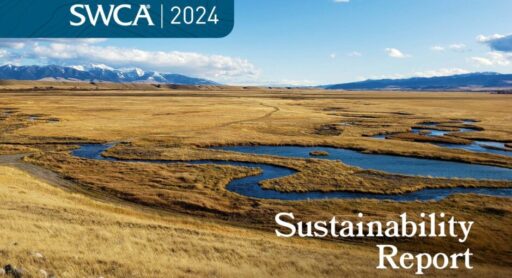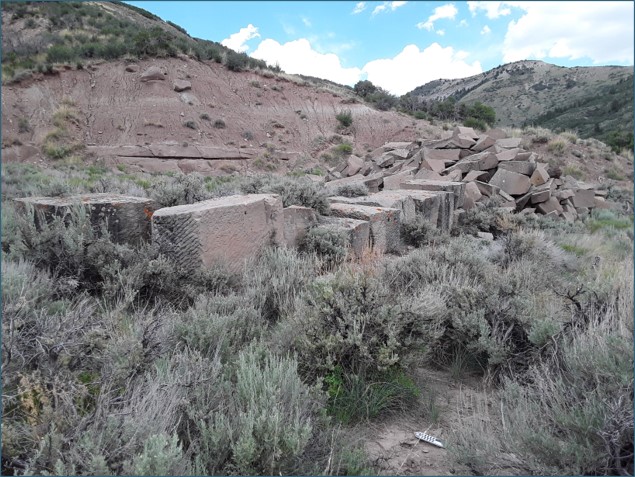2025
Comparably’s Best Company Outlook
* Providing engineering services in these locations through SWCA Environmental Consulting & Engineering, Inc., an affiliate of SWCA.

From the experts we hire, to the clients we partner with, our greatest opportunity for success lies in our ability to bring the best team together for every project.
That’s why:

At SWCA, sustainability means balancing humanity’s social, economic, and environmental needs to provide a healthy planet for future generations.

SWCA employs smart, talented, problem-solvers dedicated to our purpose of preserving natural and cultural resources for tomorrow while enabling projects that benefit people today.

At SWCA, you’re not just an employee. You’re an owner. Everyone you work with has a stake in your success, so your hard work pays off – for the clients, for the company, and for your retirement goals.
Chiseled From Time: Historical Research on Potter’s Quarry Near Salt Lake City
Nestled in the rugged landscape, far from any town or familiar landmark, lay the remnants of what appeared to be an abandoned sandstone quarry.
In the summer of 2020, an SWCA archaeological team conducted a routine survey for a proposed transmission line in Utah County, Utah, when they stumbled upon an unexpected piece of Utah history.
What could this be?
Nestled in the rugged landscape, far from any town or familiar landmark, lay the remnants of what appeared to be an abandoned sandstone quarry. The crumbling remains of a railroad spur nearby, partially dismantled but still visible in places, hinted at a forgotten chapter of industrial progress. Steps leading into what seemed like a root cellar and scattered fragments of historic glass, ceramics, and metal lay quietly beneath the dust, waiting for someone to uncover their story.
“We were so curious about the history of this place. What happened here, and what was the sandstone quarried for? The location was so out of the way – how had someone developed such a place in this remote location? Where was the sandstone taken, and how far had it traveled?” described Suzanne Eskenazi, Principal Investigator out of our Salt Lake City office. “I remember our team being so eager to research the background of this site and figure out if it was related to a historically significant person or place.”

Quarried sandstone at Potter’s Quarry
Since the remnants of the abandoned quarry were on private property and mostly outside the transmission line construction area, mitigation was required for the portion that would be impacted. Before any construction began, SWCA developed and secured approval for a Historic Properties Treatment Plan (HPTP), outlining mitigation steps to be reviewed by the Utah State Historic Preservation Office and the Bureau of Land Management, along with conducting supporting historical research.
With this framework in place, SWCA’s historical research on the archaeological site proceeded concurrently with construction, allowing the client’s project to stay on schedule.
Eskenazi and her team researched land patents and census records and found newspaper articles about quarries in the area. They examined rail line spurs that crossed near the site and consulted additional Utah archaeologists familiar with historic hard rock mining. As a part of the mitigation measures, the team took detailed photographs of the mine features and the rail line fragments. SWCA’s team ensured that the client remained compliant with all cultural resources and historic preservation regulations throughout the process.

Retaining wall at Potter’s Quarry
As SWCA archaeologists delved into the historical record, the story of Potter’s Quarry emerged – named after Gilbert Raymond Potter, a mining broker from Salt Lake City who ventured into the stone business at the turn of the 20th century. Historic maps revealed the existence of the Potter’s Quarry Spur, a short but significant railway extension branching off the Denver & Rio Grande Western Railroad. Built in 1900, the spur transported sandstone from Potter’s Quarry westward to Kyune, Utah, where it connected to the main rail line and began its journey to cities far beyond Utah’s rural expanse.
For nearly two decades, this railway line played a critical role in moving sandstone into the heart of urban development. But where did all that stone end up?
Research uncovered that Potter’s Quarry supplied sandstone for some of Salt Lake City’s most iconic buildings. Most notably, it helped shape the majestic Cathedral of the Madeleine. An article in an 1899 issue of the Intermountain Catholic newspaper reported that Potter’s quarry provided Kyune sandstone, which the Rio Grande & Western Railway transported to build the cathedral’s walls, towers, and ornamental features. Construction of the cathedral spanned nearly a decade, from 1900 to 1909, and the building is now proudly listed on the National Register of Historic Places.
The Frank E. Moss U.S. Courthouse, constructed between 1902 and 1905, also features sandstone from the same region. This courthouse, originally the U.S. Post Office and Courthouse, remains an architectural gem of Salt Lake City.
While builders initially favored Kyune sandstone for its fine appearance and superior quality, time exposed its limitations. The sandstone proved to be too soft, prone to cracking and spalling. By 1932, architects chose more durable materials like granite for building additions, having learned from the stone’s early failures. In 1977, restoration crews replaced much of the Cathedral of the Madeleine’s original sandstone due to deterioration.
“This historical research reminded me that you never know what you’re going to find, and it preserved my desire to be curious and keep wondering what’s next as a researcher,” comments Sarah Nicolaysen, Cultural Resources Technical Director. “Plus, you don’t often tie what you find in the field with a building downtown where you live!”

The modern-day Cathedral of Madeline
Through detailed historical research, we’ve come to understand that the quarry, though short-lived, served as a tangible element of history. The sandstone extracted from this remote site contributed to Salt Lake City’s architectural legacy, shaping buildings that still stand today.
Now, the transmission line is complete and in operation, and the history of the quarry is recorded forever.
“This project gave us the rare opportunity to understand how we’re connected to what we’re finding, and how there’s a direct link between our work and modern life,” highlights Eskenazi. “For our team, this project was about reconnecting with a piece of history that had remained buried for over a century.”
At SWCA, we believe that every project, no matter how routine, has the potential to reveal something extraordinary. Potter’s Quarry reminds us that cultural resources often lie barely out of sight, waiting to be uncovered and shared.
Discover more about Potter’s Quarry via the Utah State Historic Preservation Office.
Learn about Cultural Resources services at SWCA.